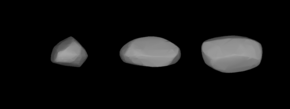Asteroid
1927 Suvanto , provisional designation 1936 FP , is a stony Eunomian asteroid from the central region of the asteroid belt , approximately 12 kilometers in diameter. It was discovered on 18 March 1936, by Finnish astronomer Rafael Suvanto at the Turku Observatory in Southwest Finland.[ 10] [ 2]
Orbit and classification
Suvanto is a member of the Eunomia family , the most prominent family in the intermediate main-belt, which mostly consists of stony S-type asteroids. It orbits the Sun at a distance of 2.3–3.0 AU once every 4 years and 4 months (1,577 days). Its orbit has an eccentricity of 0.15 and an inclination of 13° with respect to the ecliptic .[ 1]
Physical characteristics
It will pass 0.048 AU (7,200,000 km) from 2 Pallas on 24 May 2074, which will allow a refinement to the known mass of Pallas.[ 1]
Photometric observations of Suvanto collected during 2004–2005 show a rotation period of magnitude .[ 7]
Naming
This minor planet was named in memory of Rafael Suvanto (credited discoverer), assistant of Yrjö Väisälä . Suvanto died during the last days of the Finnish Winter War of in the Battle of Summa (also see naming of asteroid 1928 Summa ) .[ 2] Minor Planet Center on 1 August 1980 (M.P.C. 5450[ 11]
References
^ a b c d e "JPL Small-Body Database Browser: 1927 Suvanto (1936 FP)" (2017-02-26 last obs.). Jet Propulsion Laboratory . Retrieved 15 June 2017 .^ a b c Schmadel, Lutz D. (2007). "(1927) Suvanto". Dictionary of Minor Planet Names – (1927) Suvanto . Springer Berlin Heidelberg . p. 155. doi :10.1007/978-3-540-29925-7_1928 . ISBN 978-3-540-00238-3 ^ a b c d e "LCDB Data for (1927) Suvanto" . Asteroid Lightcurve Database (LCDB). Retrieved 15 June 2017 .^ a b Masiero, Joseph R.; Grav, T.; Mainzer, A. K.; Nugent, C. R.; Bauer, J. M.; Stevenson, R.; et al. (August 2014). "Main-belt Asteroids with WISE/NEOWISE: Near-infrared Albedos" . The Astrophysical Journal . 791 (2): 11. arXiv :1406.6645 Bibcode :2014ApJ...791..121M . doi :10.1088/0004-637X/791/2/121 . Retrieved 14 June 2017 . ^ a b c Masiero, Joseph R.; Mainzer, A. K.; Grav, T.; Bauer, J. M.; Cutri, R. M.; Nugent, C.; et al. (November 2012). "Preliminary Analysis of WISE/NEOWISE 3-Band Cryogenic and Post-cryogenic Observations of Main Belt Asteroids" . The Astrophysical Journal Letters . 759 (1): 5. arXiv :1209.5794 Bibcode :2012ApJ...759L...8M . doi :10.1088/2041-8205/759/1/L8 . Retrieved 15 June 2017 . ^ a b c Mainzer, A.; Grav, T.; Masiero, J.; Hand, E.; Bauer, J.; Tholen, D.; et al. (November 2011). "NEOWISE Studies of Spectrophotometrically Classified Asteroids: Preliminary Results". The Astrophysical Journal . 741 (2): 25. arXiv :1109.6407 Bibcode :2011ApJ...741...90M . doi :10.1088/0004-637X/741/2/90 . ^ a b Pray, Donald P. (September 2005). "Lightcurve analysis of asteroids 106, 752, 847, 1057, 1630, 1670, 1927 1936, 2426, 2612, 2647, 4087, 5635, 5692, and 6235" . The Minor Planet Bulletin . 32 (3): 48– 51. Bibcode :2005MPBu...32...48P . ISSN 1052-8091 . Retrieved 15 June 2017 . ^ Behrend, Raoul. "Asteroids and comets rotation curves – (1927) Suvanto" . Geneva Observatory . Retrieved 15 June 2017 . ^ a b Veres, Peter; Jedicke, Robert; Fitzsimmons, Alan; Denneau, Larry; Granvik, Mikael; Bolin, Bryce; et al. (November 2015). "Absolute magnitudes and slope parameters for 250,000 asteroids observed by Pan-STARRS PS1 - Preliminary results" . Icarus . 261 : 34– 47. arXiv :1506.00762 Bibcode :2015Icar..261...34V . doi :10.1016/j.icarus.2015.08.007 . Retrieved 15 June 2017 . ^ "1927 Suvanto (1936 FP)" . Minor Planet Center . Retrieved 15 June 2017 .^ "MPC/MPO/MPS Archive" . Minor Planet Center . Retrieved 15 June 2017 .
External links
